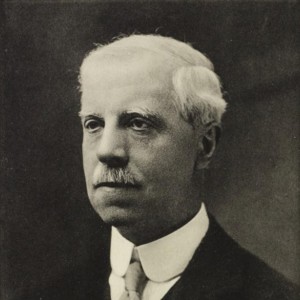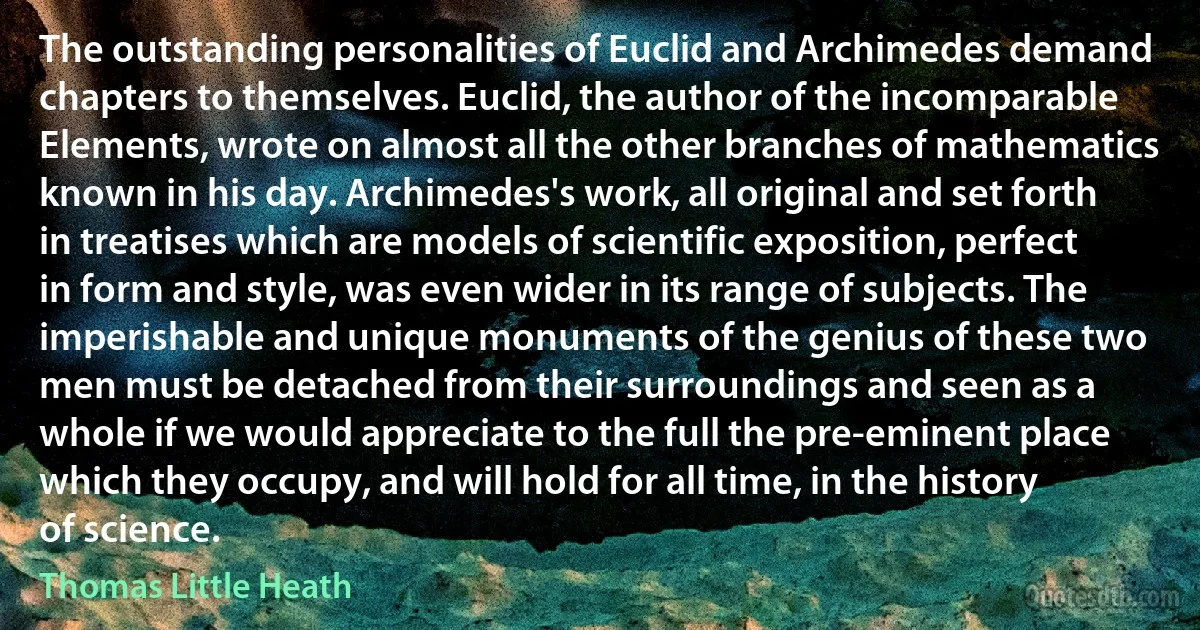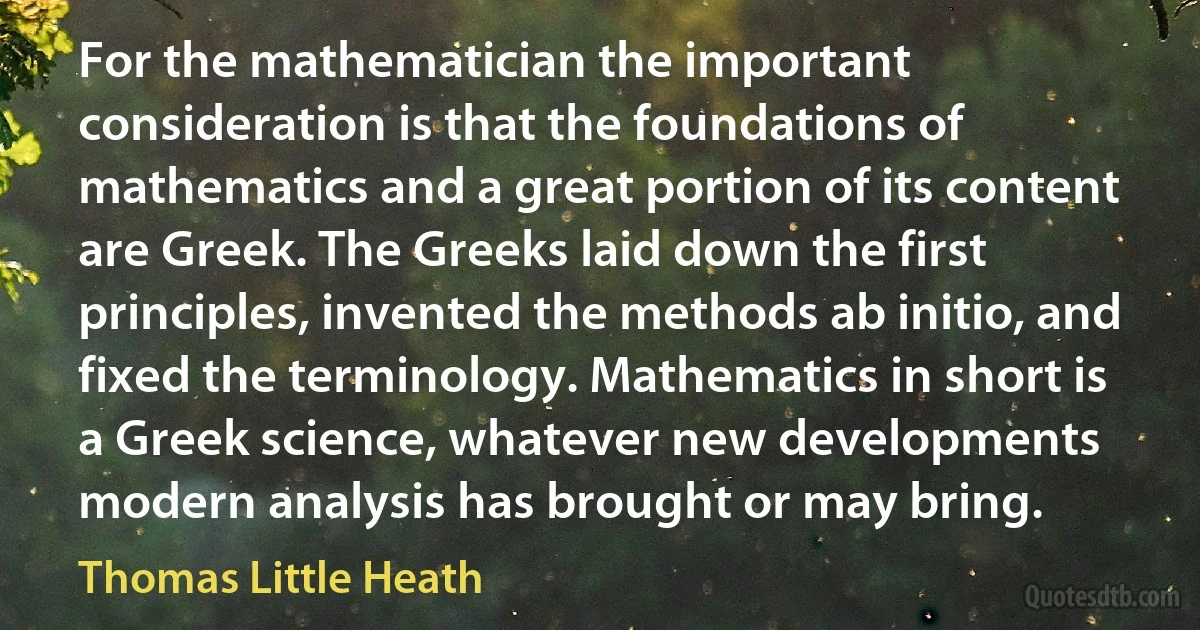Thomas Little Heath quotes
The best history of Greek mathematics which exists at present is undoubtedly that of Gino Loria under the title Le scienze esatte nell' antica Grecia (second edition 1914...) ...the arrangement is chronological ...they raise the question whether in a history of this kind it is best to follow chronological order or to arrange the material according to subjects...
I have adopted a new arrangement, mainly according to subjects...

Thomas Little Heath
Euclid's work will live long after all the text books of the present day are superseded and forgotten. It is one of the noblest monuments of antiquity; no mathematician worthy of the name can afford not to know Euclid, the real Euclid as distinct from any revised or rewritten versions which will serve for schoolboys or engineers. And, to know Euclid, it is necessary to know his language, and, so far as it can be traced, the history of the "elements" which he collected in his immortal work.

Thomas Little Heath
The Pythagoreans discovered the existence of incommensurable lines, or of irrationals. This was, doubtless, first discovered with reference to the diagonal of a square which is incommensurable with the side, being in the ratio to it of √2 to 1. The Pythagorean proof of this particular case survives in Aristotle and in a proposition interpolated in Euclid's Book X.; it is by a reductio ad absurdum proving that, if the diagonal is commensurable with the side, the same number must be both odd and even. This discovery of the incommensurable... showed that the theory of proportion invented by Pythagoras was not of universal application and therefore that propositions proved by means of it were not really established.... The fatal flaw thus revealed in the body of geometry was not removed till Eudoxus discovered the great theory of proportion (expounded in Euclid's Book V.), which is applicable to incommensurable as well as to commensurable magnitudes.

Thomas Little Heath
Any satisfactory reproduction of the Conics must fulfil certain essential conditions: (1) it should be Apollonius and nothing but Apollonius, and nothing should be altered either in the substance or in the order of his thought, (2) it should be complete, leaving out nothing of any significance or importance, (3) it should exhibit under different headings the successive divisions of the subject, so that the definite scheme followed by the author may be seen as a whole.

Thomas Little Heath
An edition is... still wanted which shall, while in some places adhering... to the original text, at the same time be so entirely remodelled by the aid of accepted modern notation as to be thoroughly readable by any competent mathematician, and this want it is the object of the present work to supply.

Thomas Little Heath
Menæchmus, a pupil of Eudoxus, and a contemporary of Plato, found the two mean proportionals by means of conic sections, in two ways, (α) by the intersection of two parabolas, the equations of which in Cartesian co-ordinates would be x2=ay, y2=bx, and (β) by the intersection of a parabola and a rectangular hyperbola, the corresponding equations being x2=ay, and xy=ab respectively. It would appear that it was in the effort to solve this problem that Menæchmus discovered the conic sections, which are called, in an epigram by Eratosthenes, "the triads of Menæchmus."

Thomas Little Heath
By the time of Hippocrates of Chios the scope of Greek geometry was no longer even limited to the Elements; certain special problems were also attacked which were beyond the power of the geometry of the straight line and circle, and which were destined to play a great part in determining the direction taken by Greek geometry in its highest flights. The main problems in question were three: (1) the doubling of the cube, (2) the trisection of any angle, (3) the squaring of the circle; and from the time of Hippocrates onwards the investigation of these problems proceeded pari passu with the completion of the body of the Elements.

Thomas Little Heath
The researches of the last thirty or forty years into the history of mathematics (I need only mention such names as those of [Carl Anton] Bretschneider, Hankel, Moritz Cantor, [Friedrich] Hultsch, Paul Tannery, Zeuthen, Loria, and Heiberg) have put the whole subject upon a different plane. I have endeavoured in this edition to take account of all the main results of these researches up to the present date. Thus, so far as the geometrical Books are concerned, my notes are intended to form a sort of dictionary of the history of elementary geometry, arranged according to subjects; while the notes on the arithmetical Books VII.-IX. and on Book X follow the same plan.

Thomas Little Heath
The actual writers of Elements of whom we hear were the following. Leon, a little younger than Eudoxus, was the author of a collection of propositions more numerous and more serviceable than those collected by Hippocrates. Theudius of Magnesia, a contemporary of Menæchmus and Dinostratus, "put together the elements admirably, making many partial or limited propositions more general". Theudius's book was no doubt the geometrical text-book of the Academy and that used by Aristotle.

Thomas Little Heath
The efforts of a multitude of writers have rather been directed towards producing alternatives for Euclid which shall be more suitable, that is to say, easier, for schoolboys. It is of course not surprising that, in these days of short cuts, there should have arisen a movement to get rid of Euclid and to substitute "a royal road to geometry"; the marvel is that a book which was not written for schoolboys but for grown men (as all internal evidence shows, and in particular the essentially theoretical character of the work and its aloofness from anything of the nature of "practical" geometry) should have held its own as a schoolbook for so long.

Thomas Little Heath
Hippocrates also attacked the problem of doubling the cube. ...Hippocrates did not, indeed, solve the problem, but he succeeded in reducing it to another, namely, the problem of finding two mean proportionals in continued proportion between two given straight lines, i. e. finding x, y such that a:x=x:y=y:b, where a, b are the two given straight lines. It is easy to see that, if a:x=x:y=y:b, then b/a = (x/a)3, and, as a particular case, if b=2a, x3=2a3, so that the side of the cube which is double of the cube of side a is found.

Thomas Little Heath
The method of exhaustion was not discovered all at once; we find traces of gropings after such a method before it was actually evolved. It was perhaps Antiphon. the sophist, of Athens, a contemporary of Socrates, who took the first step. He inscribed a square (or, according to another account, a triangle) in a circle, then bisected the arcs subtended by the sides, and so inscribed a polygon of double the number of sides; he then repeated the process, and maintained that, by continuing it, we should at last arrive at a polygon with sides so small as to make the polygon coincident with the circle. Thought this was formally incorrect, it nevertheless contained the germ of the method of exhaustion.

Thomas Little Heath
Dr. James Gow did a great service by the publication in 1884 of his Short History of Greek Mathematics, a scholarly and useful work which has held its own and has been quoted with respect and appreciation by authorities on the history of mathematics in all parts of the world. At the date when he wrote, however, Dr. Gow had necessarily to rely upon the works of the pioneers Bretschneider, Hankel, Allman, and Moritz Cantor (first edition). Since then the subject has been very greatly advanced... scholars and mathematicians... have thrown light on many obscure points. It is therefore high time for the complete story to be rewritten.

Thomas Little Heath
It would be inconvenient to interrupt the account of Menaechmus's solution of the problem of the two mean proportionals in order to consider the way in which he may have discovered the conic sections and their fundamental properties. It seems to me much better to give the complete story of the origin and development of the geometry of the conic sections in one place, and this has been done in the chapter on conic sections associated with the name of Apollonius of Perga. Similarly a chapter has been devoted to algebra (in connexion with Diophantus) and another to trigonometry.

Thomas Little Heath
It is a defect in the existing histories that, while they state generally the contents of, and the main propositions proved in, the great treatises of Archimedes and Apollonius, they make little attempt to describe the procedure by which the results are obtained. I have therefore taken pains, in the most significant cases, to show the course of the argument in sufficient detail to enable a competent mathematician to grasp the method used and to apply it, if he will, to other similar investigations.

Thomas Little Heath
Thomas Little Heath
 Occupation: Mathematician
Occupation: Mathematician
Born: October 5, 1861
Died: March 16, 1940
Quotes count: 40






